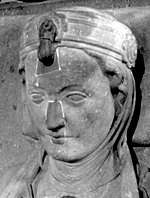Matilda of England, Duchess of Saxony
| Matilda of England | |
|---|---|
 | |
| Duchess of Saxony and of Bavaria | |
| Tenure | 1168–1180 |
| Born |
January 6, 1156 Windsor Castle, Berkshire, England |
| Died |
28 June 1189 (aged 33) Brunswick, Lower Saxony |
| Burial | Brunswick Cathedral, Lower Saxony |
| Spouse | Henry the Lion |
| Issue Detail |
Matilda, Countess of Perche and Coucy Henry V, Count Palatine of the Rhine Lothar of Bavaria Otto IV, Holy Roman Emperor, Duke of Swabia William of Winchester, Lord of Lunenburg |
| House | Plantagenet / Angevin[nb 1] |
| Father | Henry II of England |
| Mother | Eleanor of Aquitaine |
Matilda of England (also called Maud; January 6, 1156 – 28 June 1189) was the eldest daughter of Henry II, King of England and Eleanor of Aquitaine. Through her marriage with Henry the Lion, she was Duchess of Saxony and of Bavaria.
Marriage
In 1165 Rainald of Dassel, Archbishop of Cologne, arrived at the court of King Henry II at Rouen, to negotiate a German match for Matilda. There was conflict during the negotiations, however, when Robert de Beaumont, 2nd Earl of Leicester refused to greet the archbishop, alleging him to be a schismatic and a supporter of the anti-pope, Victor IV. The original plan to match a daughter of Henry II with a son of Frederick I, Holy Roman Emperor, was abandoned, and instead Matilda left England in September 1167 to marry Henry the Lion.

She married Henry the Lion, Duke of Saxony and Bavaria, on 1 February 1168 at Minden Cathedral. They had four sons and one daughter:
- Matilda (or Richenza) of Saxony (1172–1209/10), married Geoffrey III Count of Perche (see counts of Perche) and Enguerrand III, Lord of Coucy
- Henry V, Count Palatine of the Rhine (1173/1174 – 28 April 1227)
- Lothar (1174/1175 – 16 October 1190).
- Otto IV, Holy Roman Emperor and Duke of Swabia (1175/1176 – 19 May 1218).
- William, Duke of Lüneburg (11 April 1184 – 12 December 1213).
Three other children are listed, by some sources, as having belonged to Henry and Matilda:
- Eleanor (born 1178); died young
- Ingibiorg (born 1180); died young
- Son (stillborn 1182)
Regency and exile
At the time of their marriage, Henry the Lion was one of the most powerful allies of Frederick I, Holy Roman Emperor. Matilda governed her husband's vast estates during his absence in the Holy Land from 1172 to 1173. In 1174, Henry the Lion became involved in a conflict with the Emperor Frederick, and Henry and Matilda were forced to flee Germany and take refuge in Normandy at her father's court in 1182. During this time at the royal court at Argentan, Matilda became acquainted with the Troubadour Bertran de Born, who, calling her "Elena" or "Lana", made her the object of his desire in two of his poems of "courtly love".
Matilda, her husband, and their family remained in Normandy under the protection and support of King Henry until 1185, when they were allowed to return to Saxony. Early in 1189 the Emperor again ordered Henry the Lion to go into exile. This time Matilda remained at Brunswick to defend the interests of her husband but died just three months later.
Ancestry
| Ancestors of Matilda of England, Duchess of Saxony | ||||||||||||||||||||||||||||||||||||||||||||||||||||||||||||||||||||||||||||||||||||||||||||||||||||||||||||||||||||||||||||||||||||||||||||||||||||||||||||||||||||||||||||||||||||||||||||||||||||||||||||||||||||||||||||||||||||||||||||||||||||||||||||||||||||||||||||||||||||||||||||||||||||||||||||||||||||||||||||||||||||||||||||||||||||||||||||||||||||||||||||||||||||||||||||||||||||||||||||||||||||||||||||||||||||||||||||||||||||||||||||||||||||||||||||||||||||||||||||||||||||||||||||||||||||||||||||||||||
|---|---|---|---|---|---|---|---|---|---|---|---|---|---|---|---|---|---|---|---|---|---|---|---|---|---|---|---|---|---|---|---|---|---|---|---|---|---|---|---|---|---|---|---|---|---|---|---|---|---|---|---|---|---|---|---|---|---|---|---|---|---|---|---|---|---|---|---|---|---|---|---|---|---|---|---|---|---|---|---|---|---|---|---|---|---|---|---|---|---|---|---|---|---|---|---|---|---|---|---|---|---|---|---|---|---|---|---|---|---|---|---|---|---|---|---|---|---|---|---|---|---|---|---|---|---|---|---|---|---|---|---|---|---|---|---|---|---|---|---|---|---|---|---|---|---|---|---|---|---|---|---|---|---|---|---|---|---|---|---|---|---|---|---|---|---|---|---|---|---|---|---|---|---|---|---|---|---|---|---|---|---|---|---|---|---|---|---|---|---|---|---|---|---|---|---|---|---|---|---|---|---|---|---|---|---|---|---|---|---|---|---|---|---|---|---|---|---|---|---|---|---|---|---|---|---|---|---|---|---|---|---|---|---|---|---|---|---|---|---|---|---|---|---|---|---|---|---|---|---|---|---|---|---|---|---|---|---|---|---|---|---|---|---|---|---|---|---|---|---|---|---|---|---|---|---|---|---|---|---|---|---|---|---|---|---|---|---|---|---|---|---|---|---|---|---|---|---|---|---|---|---|---|---|---|---|---|---|---|---|---|---|---|---|---|---|---|---|---|---|---|---|---|---|---|---|---|---|---|---|---|---|---|---|---|---|---|---|---|---|---|---|---|---|---|---|---|---|---|---|---|---|---|---|---|---|---|---|---|---|---|---|---|---|---|---|---|---|---|---|---|---|---|---|---|---|---|---|---|---|---|---|---|---|---|---|---|---|---|---|---|---|---|---|---|---|---|---|---|---|---|---|---|---|---|---|---|---|---|---|---|---|---|---|---|---|---|---|---|---|---|---|---|---|---|---|---|---|---|---|---|---|---|---|---|---|---|---|---|---|---|---|---|---|---|---|---|---|---|---|---|---|---|---|---|---|---|---|---|---|---|---|---|---|---|---|---|---|---|---|---|---|---|---|---|---|---|---|---|---|---|---|---|---|---|---|---|---|---|---|---|---|---|---|---|---|---|---|---|---|---|---|---|---|---|---|---|---|---|---|---|---|---|---|---|
| ||||||||||||||||||||||||||||||||||||||||||||||||||||||||||||||||||||||||||||||||||||||||||||||||||||||||||||||||||||||||||||||||||||||||||||||||||||||||||||||||||||||||||||||||||||||||||||||||||||||||||||||||||||||||||||||||||||||||||||||||||||||||||||||||||||||||||||||||||||||||||||||||||||||||||||||||||||||||||||||||||||||||||||||||||||||||||||||||||||||||||||||||||||||||||||||||||||||||||||||||||||||||||||||||||||||||||||||||||||||||||||||||||||||||||||||||||||||||||||||||||||||||||||||||||||||||||||||||||
Sources
- Ralph of Diceto
- Robert of Torigny
- Wheeler, Bonnie. Eleanor of Aquitaine: Lord and Lady, 2002
- Diggelmann, Lindsay. Exile and the Poetic Standpoint of the Troubadour Bertran de Born, 2005
External links
| Wikimedia Commons has media related to Matilda of England. |
- Betran de Born, Casutz sui de mal en pena
- Bertran de Born, Ges de disnar non for'oimais maitis
Notes
- ↑ Historians are divided in their use of the terms "Plantagenet" and "Angevin" in regards to Henry II and his sons. Some class Henry II to be the first Plantagenet King of England; others refer to Henry, Richard and John as the Angevin dynasty, and consider Henry III to be the first Plantagenet ruler.
| Matilda of England, Duchess of Saxony Cadet branch of the House of Anjou Born: c. 1156 Died: 13 July 1189 | ||
| German royalty | ||
|---|---|---|
| Vacant Title last held by Clementia of Zähringen |
Duchess consort of Saxony 1168–1180 |
Succeeded by Judith of Poland |
| Duchess consort of Bavaria 1168–1180 |
Vacant Title next held by Agnes of Loon | |
.svg.png)